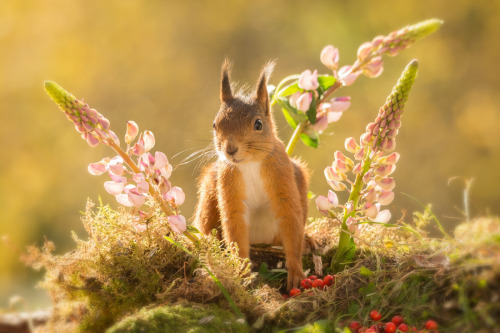C. Gockel's Blog, page 20
May 24, 2016
Me again - I've seen references to a story about how Sigyn and Loki met each other in several places, but I can't seem to find a record of it anywhere. Is there a surviving story about that, or is there just a 'mythology fanon' edition that's commonly acce
No, there is no surviving story about this from Old Norse literature. I’m not aware of any story about them meeting, so I don’t know where the story that you found comes from. For better or worse, it’s very easy to be completely exhaustive with regard to Sigyn, because there is so little lore about her. Here is a list of every reference to Sigyn in Norse mythology that I have been able to find. Since a lot of people have questions about Sigyn, I’ve decided that while this may be overkill for answering your question, others might find an exhaustive list of sources useful.
VöluspáLokasenna (epilogue):Þar sitr Sigyn
þeygi um sínum
ver velglýjuð‘There sits Sigyn (under Hveralundr, with Loki)
but not, of/concerning her
husband, happy.’
Gylfaginning “About Loki Laufeyjarson”:Sigyn, kona Loka, sat þar ok helt munnlaug undir eitrið. En er munnlaugin var full, bar hon út eitrið, en meðan draup eitrit á Loka.
‘Sigyn, Loki’s wife, sat there and held a washbasin under the venom. But when the washbasin was full, she poured the venom out, and meanwhile the venom dripped on Loki.’
Gylfaginning “Loki bound”Kona hans heitir Sigyn, sonr þeira Nari eða Narfi.
‘His wife is named Sigyn, their son is Nari or Narfi.’
Skáldskaparmál…en Sigyn, kona hans, stendr hjá honum ok heldr mundlaug undir eitrdropa. En þá er full er mundlaugin, þá gengr hon ok slær út eitrinu, en meðan drýpr eitrit í andlit honum.
‘…but Sigyn, his wife, stands next to him and holds a washbasin under the venom drops. But then when the washbasin is full, she goes and pours out the venom, and meanwhile the venom drips onto his face.’
In the beginning of Skáldskaparmál she is listed among the deities who are present when they host Ægir. Later in the list of kennings for Loki, ver Sigynjar ‘husband of Sigyn’ is mentioned.
NafnaþulurIn Nafnaþulur, the name Sigyn is listed under names of Ásynjur and a list of women’s names (which are mostly goddess names).
Skáldic PoetryThere are two kennings for Loki in skáldic poetry that refer to him in relation to Sigyn. The first is farmr Sigynjar arma ‘burden of Sigyn’s arms’ from Haustlǫng by Þjóðólfr úr Hvini.
The second is farmr arma hafts galdrs, from Þórsdrápa by Eilífr Goðrúnarson from around the year 1000. This is a compound kenning, and it’s not certain that this is the order of the words; skáldic poetry has extremely open-ended sentence structure and words, which are marked for grammar by their ending, can appear in nearly any order, but in this case three of four words are in the genitive case making it impossible to determine the order by means of grammar. However it clearly follows the same pattern as Þjóðólfr’s Loki-kenning mentioned above. It seems interpretable ‘burden of the arms of (the) magic-deity’ (from haft, literally ‘fetter’ but often refers to the gods, especially in the plural hǫft) or ‘burden of the arms of (the) captive of magic’ (from haftr ‘prisoner, captive’).
On the Skáldic Poetry Project website, they’ve analyzed Eilífr’s verse completely differently, so that the kenning is farmr arma meinsvarra and translated ‘The cargo of the arms of the harm-woman,’ but this is so far unpublished and it’s not clear how the rest of the verse was analyzed (that is, what galdrs and hafts are supposed to mean in that case).
The Gosforth CrossThe last is not a textual reference but rather the image carved on the Gosforth Cross, a stone cross in Gosforth, England, depicting scenes from Norse mythology, particularly from ragnarök:
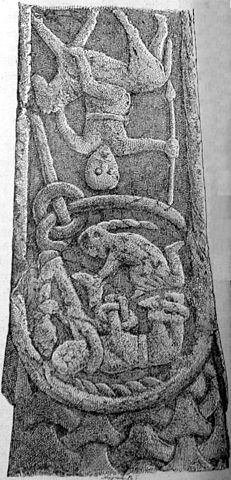
These are all of the references that I have ever managed to find to Sigyn. It’s not impossible that I missed something, but here’s how I searched in case anyone wants to look for more: searched “Sigyn” and “Loki” on the Skáldic Poetry Project, searched “Sigyn”, “Sigynjar”, “Sigvin”, and “Sigvinjar” on the Árni Magnússon Institute’s database of Norse/Icelandic texts, looked up “Sigyn” in Finnur Jónsson’s version of Sveinbjörn Egilsson’s Lexicon Poeticum. That’s pretty thorough, but it would not turn up the Gosforth Cross for example, I just happened to know about that.
- Þorraborinn
Me again - I've seen references to a story about how Sigyn and Loki met each other in several places, but I can't seem to find a record of it anywhere. Is there a surviving story about that, or is there just a 'mythology fanon' edition that's commonly acce
No, there is no surviving story about this from Old Norse literature. I’m not aware of any story about them meeting, so I don’t know where the story that you found comes from. For better or worse, it’s very easy to be completely exhaustive with regard to Sigyn, because there is so little lore about her. Here is a list of every reference to Sigyn in Norse mythology that I have been able to find. Since a lot of people have questions about Sigyn, I’ve decided that while this may be overkill for answering your question, others might find an exhaustive list of sources useful.
VöluspáLokasenna (epilogue):Þar sitr Sigyn
þeygi um sínum
ver velglýjuð‘There sits Sigyn (under Hveralundr, with Loki)
but not, of/concerning her
husband, happy.’
Gylfaginning “About Loki Laufeyjarson”:Sigyn, kona Loka, sat þar ok helt munnlaug undir eitrið. En er munnlaugin var full, bar hon út eitrið, en meðan draup eitrit á Loka.
‘Sigyn, Loki’s wife, sat there and held a washbasin under the venom. But when the washbasin was full, she poured the venom out, and meanwhile the venom dripped on Loki.’
Gylfaginning “Loki bound”Kona hans heitir Sigyn, sonr þeira Nari eða Narfi.
‘His wife is named Sigyn, their son is Nari or Narfi.’
Skáldskaparmál…en Sigyn, kona hans, stendr hjá honum ok heldr mundlaug undir eitrdropa. En þá er full er mundlaugin, þá gengr hon ok slær út eitrinu, en meðan drýpr eitrit í andlit honum.
‘…but Sigyn, his wife, stands next to him and holds a washbasin under the venom drops. But then when the washbasin is full, she goes and pours out the venom, and meanwhile the venom drips onto his face.’
In the beginning of Skáldskaparmál she is listed among the deities who are present when they host Ægir. Later in the list of kennings for Loki, ver Sigynjar ‘husband of Sigyn’ is mentioned.
NafnaþulurIn Nafnaþulur, the name Sigyn is listed under names of Ásynjur and a list of women’s names (which are mostly goddess names).
Skáldic PoetryThere are two kennings for Loki in skáldic poetry that refer to him in relation to Sigyn. The first is farmr Sigynjar arma ‘burden of Sigyn’s arms’ from Haustlǫng by Þjóðólfr úr Hvini.
The second is farmr arma hafts galdrs, from Þórsdrápa by Eilífr Goðrúnarson from around the year 1000. This is a compound kenning, and it’s not certain that this is the order of the words; skáldic poetry has extremely open-ended sentence structure and words, which are marked for grammar by their ending, can appear in nearly any order, but in this case three of four words are in the genitive case making it impossible to determine the order by means of grammar. However it clearly follows the same pattern as Þjóðólfr’s Loki-kenning mentioned above. It seems interpretable ‘burden of the arms of (the) magic-deity’ (from haft, literally ‘fetter’ but often refers to the gods, especially in the plural hǫft) or ‘burden of the arms of (the) captive of magic’ (from haftr ‘prisoner, captive’).
On the Skáldic Poetry Project website, they’ve analyzed Eilífr’s verse completely differently, so that the kenning is farmr arma meinsvarra and translated ‘The cargo of the arms of the harm-woman,’ but this is so far unpublished and it’s not clear how the rest of the verse was analyzed (that is, what galdrs and hafts are supposed to mean in that case).
The Gosforth CrossThe last is not a textual reference but rather the image carved on the Gosforth Cross, a stone cross in Gosforth, England, depicting scenes from Norse mythology, particularly from ragnarök:

These are all of the references that I have ever managed to find to Sigyn. It’s not impossible that I missed something, but here’s how I searched in case anyone wants to look for more: searched “Sigyn” and “Loki” on the Skáldic Poetry Project, searched “Sigyn”, “Sigynjar”, “Sigvin”, and “Sigvinjar” on the Árni Magnússon Institute’s database of Norse/Icelandic texts, looked up “Sigyn” in Finnur Jónsson’s version of Sveinbjörn Egilsson’s Lexicon Poeticum. That’s pretty thorough, but it would not turn up the Gosforth Cross for example, I just happened to know about that.
- Þorraborinn
Me again - I've seen references to a story about how Sigyn and Loki met each other in several places, but I can't seem to find a record of it anywhere. Is there a surviving story about that, or is there just a 'mythology fanon' edition that's commonly acce
No, there is no surviving story about this from Old Norse literature. I’m not aware of any story about them meeting, so I don’t know where the story that you found comes from. For better or worse, it’s very easy to be completely exhaustive with regard to Sigyn, because there is so little lore about her. Here is a list of every reference to Sigyn in Norse mythology that I have been able to find. Since a lot of people have questions about Sigyn, I’ve decided that while this may be overkill for answering your question, others might find an exhaustive list of sources useful.
VöluspáLokasenna (epilogue):Þar sitr Sigyn
þeygi um sínum
ver velglýjuð‘There sits Sigyn (under Hveralundr, with Loki)
but not, of/concerning her
husband, happy.’
Gylfaginning “About Loki Laufeyjarson”:Sigyn, kona Loka, sat þar ok helt munnlaug undir eitrið. En er munnlaugin var full, bar hon út eitrið, en meðan draup eitrit á Loka.
‘Sigyn, Loki’s wife, sat there and held a washbasin under the venom. But when the washbasin was full, she poured the venom out, and meanwhile the venom dripped on Loki.’
Gylfaginning “Loki bound”Kona hans heitir Sigyn, sonr þeira Nari eða Narfi.
‘His wife is named Sigyn, their son is Nari or Narfi.’
Skáldskaparmál…en Sigyn, kona hans, stendr hjá honum ok heldr mundlaug undir eitrdropa. En þá er full er mundlaugin, þá gengr hon ok slær út eitrinu, en meðan drýpr eitrit í andlit honum.
‘…but Sigyn, his wife, stands next to him and holds a washbasin under the venom drops. But then when the washbasin is full, she goes and pours out the venom, and meanwhile the venom drips onto his face.’
In the beginning of Skáldskaparmál she is listed among the deities who are present when they host Ægir. Later in the list of kennings for Loki, ver Sigynjar ‘husband of Sigyn’ is mentioned.
NafnaþulurIn Nafnaþulur, the name Sigyn is listed under names of Ásynjur and a list of women’s names (which are mostly goddess names).
Skáldic PoetryThere are two kennings for Loki in skáldic poetry that refer to him in relation to Sigyn. The first is farmr Sigynjar arma ‘burden of Sigyn’s arms’ from Haustlǫng by Þjóðólfr úr Hvini.
The second is farmr arma hafts galdrs, from Þórsdrápa by Eilífr Goðrúnarson from around the year 1000. This is a compound kenning, and it’s not certain that this is the order of the words; skáldic poetry has extremely open-ended sentence structure and words, which are marked for grammar by their ending, can appear in nearly any order, but in this case three of four words are in the genitive case making it impossible to determine the order by means of grammar. However it clearly follows the same pattern as Þjóðólfr’s Loki-kenning mentioned above. It seems interpretable ‘burden of the arms of (the) magic-deity’ (from haft, literally ‘fetter’ but often refers to the gods, especially in the plural hǫft) or ‘burden of the arms of (the) captive of magic’ (from haftr ‘prisoner, captive’).
On the Skáldic Poetry Project website, they’ve analyzed Eilífr’s verse completely differently, so that the kenning is farmr arma meinsvarra and translated ‘The cargo of the arms of the harm-woman,’ but this is so far unpublished and it’s not clear how the rest of the verse was analyzed (that is, what galdrs and hafts are supposed to mean in that case).
The Gosforth CrossThe last is not a textual reference but rather the image carved on the Gosforth Cross, a stone cross in Gosforth, England, depicting scenes from Norse mythology, particularly from ragnarök:

These are all of the references that I have ever managed to find to Sigyn. It’s not impossible that I missed something, but here’s how I searched in case anyone wants to look for more: searched “Sigyn” and “Loki” on the Skáldic Poetry Project, searched “Sigyn”, “Sigynjar”, “Sigvin”, and “Sigvinjar” on the Árni Magnússon Institute’s database of Norse/Icelandic texts, looked up “Sigyn” in Finnur Jónsson’s version of Sveinbjörn Egilsson’s Lexicon Poeticum. That’s pretty thorough, but it would not turn up the Gosforth Cross for example, I just happened to know about that.
- Þorraborinn
Me again - I've seen references to a story about how Sigyn and Loki met each other in several places, but I can't seem to find a record of it anywhere. Is there a surviving story about that, or is there just a 'mythology fanon' edition that's commonly acce
No, there is no surviving story about this from Old Norse literature. I’m not aware of any story about them meeting, so I don’t know where the story that you found comes from. For better or worse, it’s very easy to be completely exhaustive with regard to Sigyn, because there is so little lore about her. Here is a list of every reference to Sigyn in Norse mythology that I have been able to find. Since a lot of people have questions about Sigyn, I’ve decided that while this may be overkill for answering your question, others might find an exhaustive list of sources useful.
VöluspáLokasenna (epilogue):Þar sitr Sigyn
þeygi um sínum
ver velglýjuð‘There sits Sigyn (under Hveralundr, with Loki)
but not, of/concerning her
husband, happy.’
Gylfaginning “About Loki Laufeyjarson”:Sigyn, kona Loka, sat þar ok helt munnlaug undir eitrið. En er munnlaugin var full, bar hon út eitrið, en meðan draup eitrit á Loka.
‘Sigyn, Loki’s wife, sat there and held a washbasin under the venom. But when the washbasin was full, she poured the venom out, and meanwhile the venom dripped on Loki.’
Gylfaginning “Loki bound”Kona hans heitir Sigyn, sonr þeira Nari eða Narfi.
‘His wife is named Sigyn, their son is Nari or Narfi.’
Skáldskaparmál…en Sigyn, kona hans, stendr hjá honum ok heldr mundlaug undir eitrdropa. En þá er full er mundlaugin, þá gengr hon ok slær út eitrinu, en meðan drýpr eitrit í andlit honum.
‘…but Sigyn, his wife, stands next to him and holds a washbasin under the venom drops. But then when the washbasin is full, she goes and pours out the venom, and meanwhile the venom drips onto his face.’
In the beginning of Skáldskaparmál she is listed among the deities who are present when they host Ægir. Later in the list of kennings for Loki, ver Sigynjar ‘husband of Sigyn’ is mentioned.
NafnaþulurIn Nafnaþulur, the name Sigyn is listed under names of Ásynjur and a list of women’s names (which are mostly goddess names).
Skáldic PoetryThere are two kennings for Loki in skáldic poetry that refer to him in relation to Sigyn. The first is farmr Sigynjar arma ‘burden of Sigyn’s arms’ from Haustlǫng by Þjóðólfr úr Hvini.
The second is farmr arma hafts galdrs, from Þórsdrápa by Eilífr Goðrúnarson from around the year 1000. This is a compound kenning, and it’s not certain that this is the order of the words; skáldic poetry has extremely open-ended sentence structure and words, which are marked for grammar by their ending, can appear in nearly any order, but in this case three of four words are in the genitive case making it impossible to determine the order by means of grammar. However it clearly follows the same pattern as Þjóðólfr’s Loki-kenning mentioned above. It seems interpretable ‘burden of the arms of (the) magic-deity’ (from haft, literally ‘fetter’ but often refers to the gods, especially in the plural hǫft) or ‘burden of the arms of (the) captive of magic’ (from haftr ‘prisoner, captive’).
On the Skáldic Poetry Project website, they’ve analyzed Eilífr’s verse completely differently, so that the kenning is farmr arma meinsvarra and translated ‘The cargo of the arms of the harm-woman,’ but this is so far unpublished and it’s not clear how the rest of the verse was analyzed (that is, what galdrs and hafts are supposed to mean in that case).
The Gosforth CrossThe last is not a textual reference but rather the image carved on the Gosforth Cross, a stone cross in Gosforth, England, depicting scenes from Norse mythology, particularly from ragnarök:

These are all of the references that I have ever managed to find to Sigyn. It’s not impossible that I missed something, but here’s how I searched in case anyone wants to look for more: searched “Sigyn” and “Loki” on the Skáldic Poetry Project, searched “Sigyn”, “Sigynjar”, “Sigvin”, and “Sigvinjar” on the Árni Magnússon Institute’s database of Norse/Icelandic texts, looked up “Sigyn” in Finnur Jónsson’s version of Sveinbjörn Egilsson’s Lexicon Poeticum. That’s pretty thorough, but it would not turn up the Gosforth Cross for example, I just happened to know about that.
- Þorraborinn
May 22, 2016
cgockel:
Fates: I Bring the Fire Part IV is now available in...

Fates: I Bring the Fire Part IV is now available in dead tree skin format! (Okay, technically, paper is tree meat, but “dead tree skin” has a better ring to it.) I Bring the Fire is a USA Today bestselling series about Loki, Norse God of Mischief & Chaos. You can pick up the first in series FREE as an ebook at Amazon, Nook, iBooks, Kobo, Smashwords, and GooglePlay. (It’s also available as an audiobook, and paperback, of course!)
May 19, 2016
koshkazen:
lupine squirrel by Geert Weggen
Ratatoskr you...
May 17, 2016
therealvictoria:
soltian:
One did I see | in the wet woods...
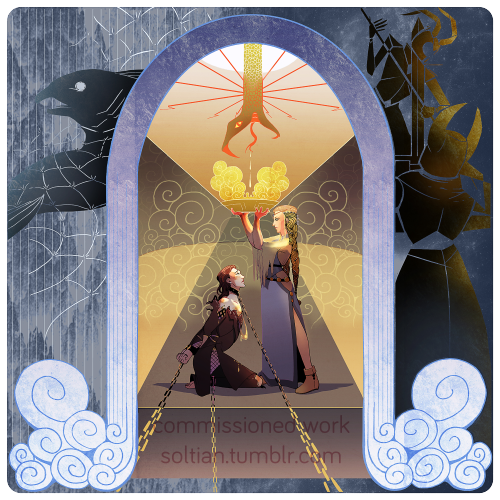
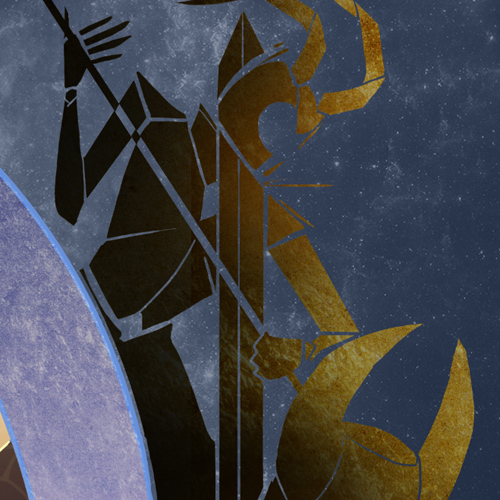
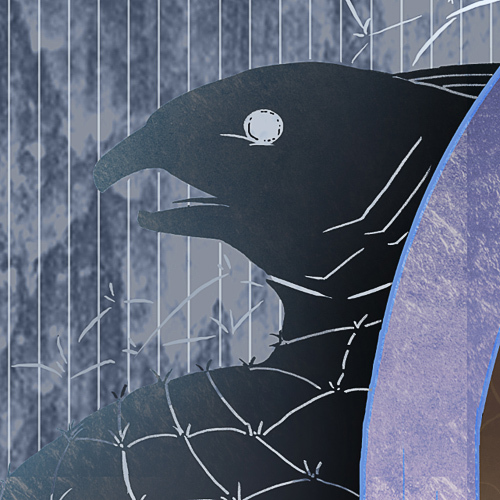
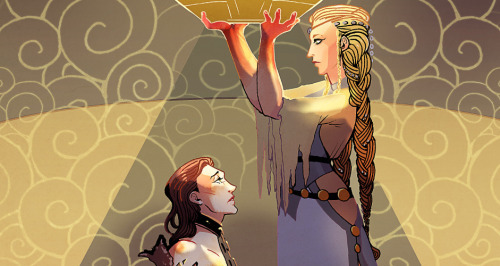
This particular drawing has rendered itself somewhat momentous to me, because at the time that my utterly lovely, patient, saint-like commissioner requested it I was seized with SO MANY visions of how to accomplish it, and drove myself crazy trying to do justice to the mythos of the situation and the very unique relationship between Loki and Sigyn that can be inferred from the glimpses of her we still have. In the end I was struck most deeply by the phrase used to describe Loki as “the burden of Sigyn’s arms”, which brought to mind a very specific sort of temperance and strength not necessarily wrought in muscle, but unwavering loyalty.
So, in honor of that. Loki and Sigyn.
This is breathtaking work. Simply gorgeous.
May 16, 2016
Calling fantasy illustrators of colour!
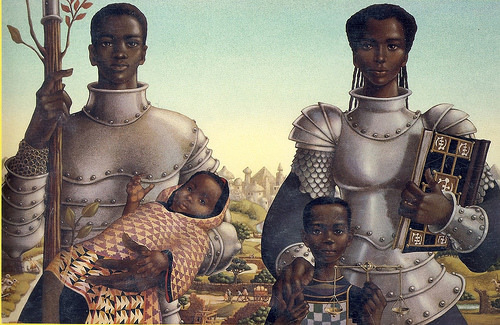
Media Diversified is looking for an illustrator of colour specialising in fantasy to provide art for our upcoming ebook.
The ebook will collect the articles by Phenderson Djeli Clark in our Fantasy’s Othering Fetish series (originally published here, here and here), plus visuals provided by an artist – who could be you!
This is a paid job, with the potential to get your work to a large audience; we’re planning to publish the book on Amazon as well as selling it through our site.
For more information, email us at info@mediadiversified.org.
Now FREE EVERYWHERE Carl Sagan’s Hunt for Intelligent Life in...

Now FREE EVERYWHERE
Carl Sagan’s Hunt for Intelligent Life in the Universe.
Sometimes intelligent life is right in front of your whiskers.
Hsissh is a member of The One. There are some newcomers to The One’s homeplanet. They call themselves “humans,” and they are, frankly, mentally deficient–they can’t warp the quantum world with their minds. However, Hsissh is becoming attached to one of them, a Miss Noa Sato.
When The One decide they will wipe out the humans and Noa’s life is on the line, Hsissh is forced to take sides … he might find intelligent life where The One least expect it.
Get it at Amazon, Nook, iBooks, Kobo, GooglePlay, and Smashwords.

